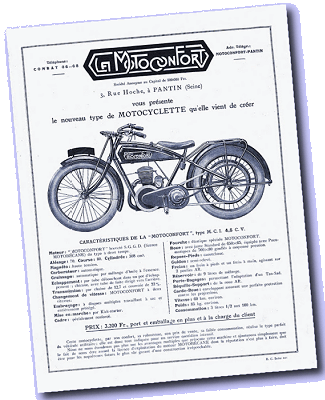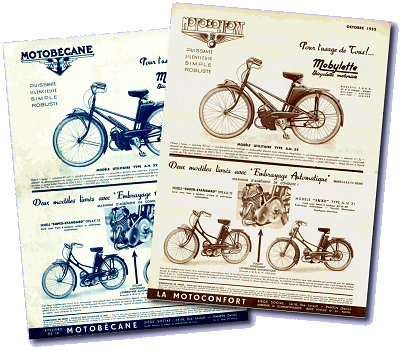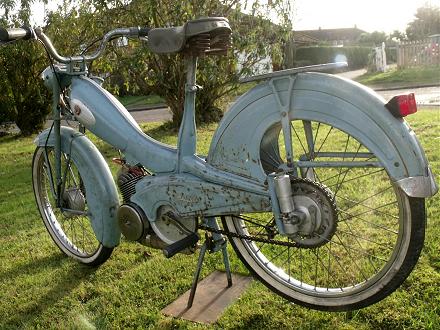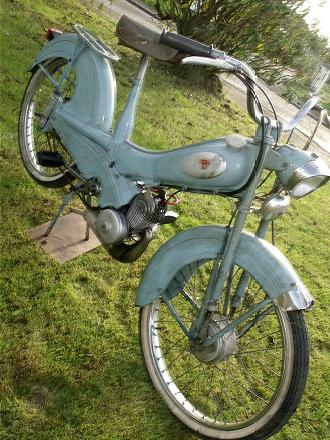Over the last few years, the IceniCAM/EACC team has been raising increasing numbers of dating certificates for registration of recently imported French market mopeds, of which many have been various Mobylette models.
 A proportion of this new wave of asylum-seeking
Mobylettes is models that were never sold in the UK, and some are identified by an AU
prefix, rather than the AV prefix we’re more familiar with
in Britain … so we’re going back to the beginning to
try to figure out what the prefix is about.
A proportion of this new wave of asylum-seeking
Mobylettes is models that were never sold in the UK, and some are identified by an AU
prefix, rather than the AV prefix we’re more familiar with
in Britain … so we’re going back to the beginning to
try to figure out what the prefix is about.
‘Motobécane’ is a compound of ‘moto’ (being French slang for ‘motor cycle’), and ‘bécane’ (being French slang for ‘bike’).
Les Ateliers de la Motobécane was officially created at 10 minutes past 2 in the afternoon on 27 March 1923 when Jules Benezech recorded the company with the Tribunal de Commerce de la Seine. The company was registered with a capital of 500,000 Francs, situated at 13 rue Beaurepair, Pantin with Abel Bardin named as directeur general. Although he founded the company, Jules Benezech has been largely forgotten by history, content to take a back seat while his two friends, Charles Benoît and Abel Bardin are remembered as the fathers of Motobécane. By the end of 1925, there was still only a single, small capacity model being produced and expanding the range into larger capacity machines would mean breaking into the market of established larger manufacturers. This would involve a degree of commercial risk, so a new company was created on 26 December 1925: Motoconfort at 3 rue Hoche, Pantin. That way, if the launch of the new 308cc Motoconfort motor cycle ended in disaster, then production of the Motobécane MB1 would not be compromised. This spreading of risk further continued with the creation of Novi in 1926 to produce the electrical equipment for the two marques.
By 1928 the larger motor cycles had established themselves in the market and the decision was made to merge the two ranges. Both distinct Motobécane and Motoconfort brands would remain, but now the full range of machines would be offered under both marques using different model prefixes for Motobécane and Motoconfort. This had the advantage that, with dealers throughout France signed up to either brand, all these outlets would now be able to offer the full range of machines. In the same year of 1928, another company called Polymécanique was created, to become responsible for engine production and manufacture of machine tools for the motor cycle and vélomoteur production lines.
 During the 1930s the
Motobécane and Motoconfort catalogues differed by
picturing the machines from opposite sides, but after World War
2, even this distinction had disappeared. As the years
passed, more dealers became joint
Motobécane–Motoconfort outlets, and there began to
seem less purpose to retaining the two names.
During the 1930s the
Motobécane and Motoconfort catalogues differed by
picturing the machines from opposite sides, but after World War
2, even this distinction had disappeared. As the years
passed, more dealers became joint
Motobécane–Motoconfort outlets, and there began to
seem less purpose to retaining the two names.
In 1949, Motobécane introduced a tubular frame/direct drive 50cc powered cycle, using an AV prefix for Motobécane, and AU prefix for Motoconfort; they called it Mobylette, a name that remained with the moped as the machine became widely popular. The first Motobécane pressed steel frame moped with integral 5-litre fuel tank was presented at the 1956 Paris Salon as the original AV78 plunger-frame model, which also introduced the new variator drive.
A year later there were four new models based on the same frame: AV75 (same plunger-frame as 78, but no variator), AV76 (no variator, rigid frame), AV79 (rigid frame, variated), and AV87 (forerunner of the AV88 with swing-arm rear and leading-link front suspension).
The 75 and 78 models were dropped at the end of 1959, with the plunger rear suspension being superseded by new swing-arm suspension models, though the rigid frame AV76 version continued for several more years before being succeeded by newer rigid frame models.
 Our
‘Gold Standard’ featured machine is a Motoconfort
AU75 dated 1959, and demonstrates a number of particular
continental market fittings like the V&W chrome ‘fender
trim’ embellishments, which clip-on at top front and back
rear of the mudguards, and a Motobécane electric bell
(which never complied with the period UK regulations, so was never fitted to
British market models). AU75 models were never brought to
the UK. Motor Imports
only marketed the AV76 and AV78 models, so a type-75 is unlikely
to be seen in Britain, and was only produced for less than three
years, which makes it a fairly uncommon Mobylette model.
Our
‘Gold Standard’ featured machine is a Motoconfort
AU75 dated 1959, and demonstrates a number of particular
continental market fittings like the V&W chrome ‘fender
trim’ embellishments, which clip-on at top front and back
rear of the mudguards, and a Motobécane electric bell
(which never complied with the period UK regulations, so was never fitted to
British market models). AU75 models were never brought to
the UK. Motor Imports
only marketed the AV76 and AV78 models, so a type-75 is unlikely
to be seen in Britain, and was only produced for less than three
years, which makes it a fairly uncommon Mobylette model.
While Motobécane made quite a proportion of their own parts, there was a number of proprietary market fittings, with the Gurtner 10mm carburettor, Soubitez 100mm headlamp with V-shape lens, Prior hubs laced into with Rigida rims and fitted with 2.00×19 tyres, and Lamplugh sprung saddle. Irrespective of whether they were built with a ‘single-speed fixed’ or ‘variated’ engine, all 75–79 models were originally specified with continuous-fin cylinder and 6.5:1 compression ratio, for 1.4bhp rating. The performance of our ’75 tester has subsequently been up-rated by conversion to a later specification exhaust port by enlargement from 20×7mm high, to 20×9.5mm high, which resolves four-stroking combustion issues when the engine runs off-load, by improving spent gas scavenging from the cylinder.
The cylinder head has also been changed to a later specification 7.5:1 compression head, with the combustion chamber modified so it can now be fitted without a head gasket to further boost the ratio to about 8:1 for an increased power output around 1.8bhp, so it should pull and rev somewhat better than the original specification motor. Otherwise, our bike is pretty much in standard trim. The original Gurtner B10mm carburetter remains completely unchanged.
 The
0–60 Huret speedometer might seem a little optimistic, but
we’re not sure if that’s graduated in mph or km/h due to the foggy glass.
Probably km/h, because
the bike was a French market model, though this proves not to
matter since it doesn’t indicate anyway. We
subsequently discover that’s because the Huret speedometer
and Huret drive are connected by a VDO cable, which only has a
2mm drive square, where the Huret
set requires a cable with 2.5mm
drive square. The VDO cable seemed to have been neatly
adapted to size by wrapping a strip of PVC tape around the square tang,
then forcing it into the drive and speedometer
ends—obviously that doesn’t work at all.
The
0–60 Huret speedometer might seem a little optimistic, but
we’re not sure if that’s graduated in mph or km/h due to the foggy glass.
Probably km/h, because
the bike was a French market model, though this proves not to
matter since it doesn’t indicate anyway. We
subsequently discover that’s because the Huret speedometer
and Huret drive are connected by a VDO cable, which only has a
2mm drive square, where the Huret
set requires a cable with 2.5mm
drive square. The VDO cable seemed to have been neatly
adapted to size by wrapping a strip of PVC tape around the square tang,
then forcing it into the drive and speedometer
ends—obviously that doesn’t work at all.
Power production at bottom-end revs is generally not so good on these machines, so initial take-off is a bit of a struggle on the first stage of the clutch, while the motor gently whimpers for ‘a little help please’. Just when it seems we might be starting to get going, our horse falls at the second fence as the second stage clutch shoes lock in at low revs, and suffering its lack of torque, the engine struggles against the full load of the drive ratio until around 10mph road speed when the revs begin to get up enough for the motor to start pulling of its own accord.
It’s generally better to help take-off with a little light pedal assistance in the initial phase with these single-speed motors, since they can rarely find any smart unaided getaway, and to see the suffering engine struggling on its own should generally arouse some mechanical sympathy in even the hardest iron heart. By 15mph road speed, revs are picking up, the engine is in happier ground, and goes strongly through its mid range up to around 30mph (according to conditions) where the revs begin to flatten out. The modified exhaust porting allows this motor to rev more freely up to speed, where the original 7mm high porting would have confined running to a tizzy of four-stroke firing past 25mph, so limiting the top speed by restricted scavenging of spent gas from the cylinder.
Crouching down in still conditions on the flat sees 32mph by the pace vehicle, and downhill run clocks 34. In some ways the 1.4bhp motor was a little better in the single-speed 75 & 76 models since you could at least work it up to revs. The same engine in the 77 & 78 vario-models just seemed to labour away in a flat drone against its over-geared ratio once the variator drive had changed up. The trouble with the automatic single-speed drive was its weakness on initial take-off, but once you’ve got past that initial phase and worked the engine revs up into its power band, then the motor would merrily buzz along almost indefinitely.
Lights are driven by a 6V × 12W black ‘marker’ generator coil, with 6V × 6W MES bulbs at each end, which were probably OK—until someone fitted a replacement modern rear lamp unit, which only had a BA9S socket with 6V × 3W bulb. Turn on the lights and … blimey, they’re bright … poof!
A 12W generator output into a 9W bulb rating just isn’t going to work, so that’ll be the end of those bulbs then…
Both brakes proved very capable at all times, which was no less than we expected from the 90mm Prior hubs, which have always been good quality stoppers on every fitted model we’ve ridden. The Lamplugh saddle was also a reminder of how much discomfort that seat can give. This one was slightly less saggy than the usual mini-bungee-sprung examples with commonly perished bands, because it looked as if the original bands had all been replaced with conventional saddle springs, which gave the saddle cover better support—but it was still uncomfortable.
The great thing about our AU75 is its handling. The rear plunger suspension system smoothes out the ride from the back, while not suffering the whippy & wallowy feel of typical lightweight swing-arm arrangements on bumpy bends. The plunger frame really does feel to handle better than a rigid or a swing-arm frame, and the fixed single-speed motor can get up to revs the over-geared AV78 variator engine may only ever aspire to, so the 75 actually seems to power along better than the more expensive variated ‘flagship’ model.
As well as selling a range of Mobylette imports into the UK through Motor Imports, Motobécane also licensed manufacture to Raleigh Industries, who produced their popular RM-series versions throughout the 1960s, which accounted for up to 38% of UK moped sales.
A formal merger of Motobécane and Motoconfort took place on 10 December 1976.
By the 1980s, the tide of business was generally ebbing away from the motor cycle industry, and causing difficult times for most companies left in the trade. In 1984, Motobécane entered into a new partnership with Yamaha, and re-branded itself as MBK Industrie. Within five years the Japanese manufacturer had carried the business capital to 295 million Francs and owned 99% of the business.
Mobylette models were even licensed out for production to Mopeds India Ltd and sold under the name Suvega. While modern scooters had now become the major part of the new company’s business, Mobylettes continued to be manufactured until 1997, when some 14 million mopeds had finally been produced.


